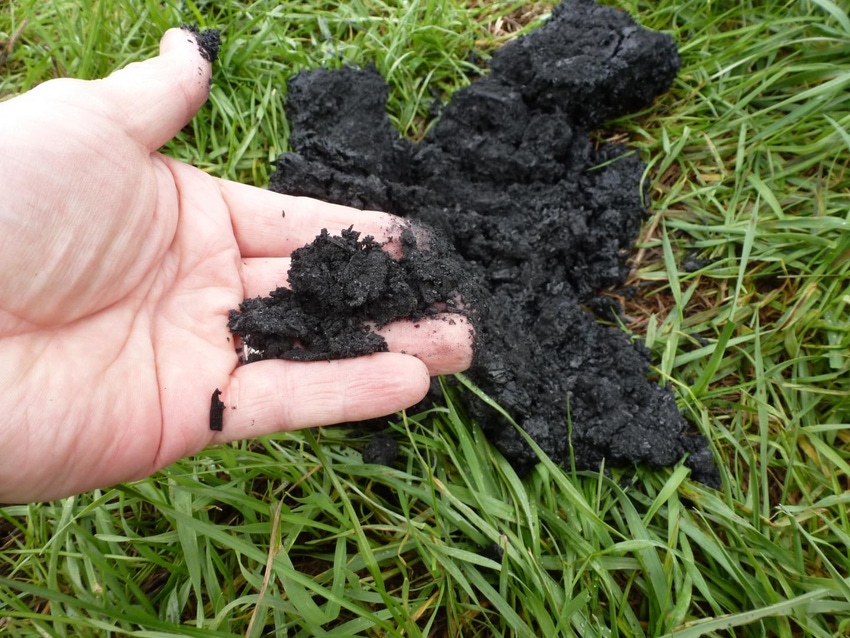Biochar could have future use as nutrient-rich soil amendment.
August 9, 2017

Manure is a reality in raising farm animals. Manure can be a useful fertilizer, returning valued nitrogen, phosphorus and potassium to the soil for plant growth. However, manure can also have problems, such as offensive odors, gas emissions, nutrient runoff and possible water pollution.
Timing is a problem as well. Livestock produce manure around the clock, even when it is impractical or unwise to move it to the field. Delivering manure to the field needs to be timed to nutrient needs, soil moisture levels and temperature. How can farmers handle this timing issue, as well as other manure problems?
On farms, manure storage lagoons can hold the manure until it is time to use. This solves the timing and delivery problem, but not the issue with odor and gas emissions. In addition to the inconvenience of odor, manure can release gases connected to air pollution and climate change, such as methane, nitrous oxide, ammonia and hydrogen sulfide.
Scientist Brian Dougherty with the department of biological and ecological engineering at Oregon State University and colleagues researched methods to reduce these negatives while potentially adding some positives: biochar covers.
Biochar is plant matter -- such as straw, woody debris or corn stalks -- that has been heated to high temperatures in a low- to no-oxygen environment. The result is a black, carbon-rich material similar to charcoal.
Dougherty said biochar is like a sponge. "Biochar provides a structure with lots of empty pore space," he explained. "The outer surface may appear small, but the interior surface area is absolutely massive. A few ounces of biochar can have an internal surface area the size of a football field. There is a lot of potential there for holding onto water and nutrients."
In addition to its hidden storage capacity, the surface of the biochar tends to have a chemical charge, which gives it the ability to attract and hold nitrogen, phosphorus and potassium ions, metals and other compounds. Biochar can also float (some types more than others), meaning that it can trap gases at the water's surface.
Dougherty grew up on a dairy farm and is no stranger to the challenges of manure storage. "Once I realized the properties of biochar, I thought it had good potential for a lagoon cover," he said.
Dougherty's research studied two types of liquid dairy manure with differing nutrient levels. It also studied two types of biochar made at different temperatures. Biochar is somewhat fickle, showcasing different properties when created at different temperatures. He also included pails of manure with a straw cover for comparison and others with no cover as his control.
The research found that the biochars picked up the most nutrients from the more concentrated manure with a higher nutrient content. "The biochar will take up whatever it can, so if there are more nutrients available the potential for nutrient uptake is greater," Dougherty noted. Nitrogen, phosphorus and potassium are nutrients with the greatest economic value on a farm, but applying them in excess of what the crop can take up can lead to nutrient loss to the watershed.
Dougherty also measured the ammonia at the top of each pail. Ammonia and sulfates are the main source of manure's odor. The cooler-crafted biochar did best here, reducing ammonia by 72-80%. It also floated better. Because it floated better and tended to repel water, it was less effective at attracting and attaching to the nutrients than the warmer-crafted biochar.
Biochar is currently more expensive to buy than straw, but Dougherty noted that biochar could have a good economic return, as excess farm and forestry residue could be used to create the biochar on site. This process generates energy that could be used to heat water and warm buildings during colder months. There is also potential for generating electricity, fuels and other byproducts using more sophisticated equipment. After its use in the lagoon, the biochar could be spread on fields as needed. Any excess could be sold as a high-value fertilizer product.
Biochar also has great environmental benefits. "Anything you can do to prevent gases from escaping the lagoon is a good thing," Dougherty said. "Biochar applied to soils — particularly poorer-quality soils — is very helpful. Making biochar can also help reduce atmospheric carbon dioxide levels. A portion of the carbon dioxide that was taken in during plant growth ends up as a very stable form of carbon in the soil. The overall picture has multiple benefits."
Dougherty's research also considered whether biochar or straw would best improve the air at a dairy. Since the human nose knows, Dougherty recruited a panel of judges. However, freezing temperatures and rain affected the odor intensity over the 12-week trial. Despite these challenges, three different biochars were shown to reduce odor from liquid dairy manure, whereas a straw cover was not effective.
"Determining the best trade-off of biochar properties will be an important next step," Dougherty said. "More research could find the right biochar production temperature, particle size, pH and float properties. The potential is there."
You May Also Like



